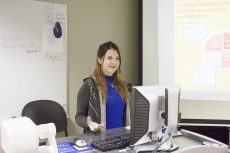By Dylan Venglar

Kaylee Jensen/The Collegian
NW Campus students learned about the circumstances and consequences of plagiarism in academic circles in Understanding and Avoiding Plagiarism Nov. 29.
Gabrielle Valentic, a full-time tutor in writing and English for foreign speakers, covered how the U.S. views the concept of plagiarism compared with other cultures.
“The U.S. has a culture of ownership many other countries and societies do not have,” she said.
Western cultures have an individual and independent approach to ideas where citation is always necessary while Asian, African and Middle Eastern societies have a communal, collective approach to ideas, and it is important to keep this in mind, Valentic said.
“Otherwise, you may come up with the perception that they’re trying to steal when it’s not the case,” she said. “We just have a different expectation.”
Valentic also told students about the different kinds of plagiarism from the most commonly known variant of direct plagiarism to indirect, patchwork and self-plagiarism.
She also reminded students to always cite a source, whether dealing with a direct quote, a paraphrase or even earlier works of their own.
“It is possible to plagiarize yourself as well,” she said.
Before a student uses their personal works from previous courses, they should get permission from all professors involved first.
Otherwise, there may be a risk of plagiarizing oneself and being marked down for it, Valentic said.
“Just ask your professors before using your own older works,” she said. “That self-citation is important to show where you relate in the research. Things changed a lot between 2010 and 2016.”





























